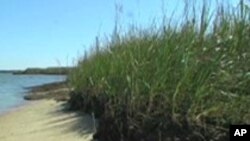Every year erosion and sea level rise are claiming about two meters of shoreline along the Chesapeake Bay on the East Coast of the United States. There have been many efforts to control the loss of land over the years, with mixed results. Now, a new approach for restoration called "living shores" has scientists hopeful.
This beach looks healthy and inviting. But until a month ago, none of this was here. All of it was man-made, with an open invitation to every living creature in the area, including this grass shrimp.
"They love restored marsh areas and they are a favorite food of strait bass and all sorts of other fish and is one species that we found significantly increases in abundance after we restore a habitat with a living shore line," Jana Davis said.
Davis is the director and chief scientist of the Chesapeake Bay Trust, a private nonprofit organization that funds restoration and education projects. She represents one of more than a dozen organizations involved in this project. "This project is a good example of the use of both natural habitat features as well as traditional armors, as you see, to protect shorelines from erosion," she said.
The team built rock lines and beaches to break the force of wind and waves, protecting shallow water and planting grasses to create a welcoming habitat.
This shoreline is part of a wildlife refuge on the upper Chesapeake Bay about 300 kilometers from the ocean. Susanne Beard is the manager for the Chesapeake Marshland National Wildlife Refuge Complex. "This is a very important piece of Eastern Neck National Wildlife Refuge because the small narrow isthmus that protects Hail Creek provides a habitat for a variety of waterfowl, fish, shellfish, all sorts of animals that live in that area," Beard said.
Hundreds of birds migrate here each year from the north to escape the hard winter months. They find rich waters with plenty of food and the right coastal habitat to survive. "It is one of the most important winter spots up and down the Chesapeake Bay," Beard adds.
But severe erosion was threatening the area. Dave Sutherland is the coastal program leader at the U.S. Fish and Wildlife Service for the Chesapeake. "The shoreline erosion is just anywhere from five (1.52 meters) to seven feet (2.13 meters) a year," he said.
Sutherland explains that while erosion has always been a natural process, climate change and human alteration of habitats have worsened the problem and the Chesapeake Bay now requires urgent restoration programs.
"With global warming, it may not be that natural," Sutherland says, "Though sea levels rise has been fairly consistent over the years, there is an accelerated rate of sea levels rise now and we are just trying to address the most critical, most high priority projects right now."
The restoration and protection program included educational activities. Grasses were planted by elementary students.
"It was a windy day, it was a rough day and the kids were great," Sutherland says, "They were taugh, they planted grass and they had a superb time."
Sutherland says these shallow waters provide the highest productivity for many species of fish and crab. The project also included an oyster restoration program. "These are oysters grown up on Eastern Neck island by Washington college and we are putting them up as our pilot study here. They should be reproducing come next season," he said.
Until not too long ago, shore protection included old techniques such as revetments, or the lying of stones right across the bank; and bulkheads, a retaining wall built to contain flooding. But while both protect the shoreline, neither leaves room for marshes or provides any habitat value.
"The theory right now is that living shorelines can respond better to sea level rise than can traditional shoreline armor," Davis states. She says it is too soon to know if the "living shoreline" experiment will work in the long term, but the restored areas are already showing some positive results.








